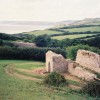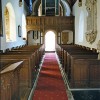The small parish of Melbury Bubb sits on the eastern slope of the wooded Bubb Down in the north west corner of the county, several miles south of Sherborne and close to the border with Somerset. “Very extensive and beautiful view” is how the Imperial Gazetteer of 1872 describes the area.
Melbury comes from the Old English ‘maele’ and ‘burh,’ translated this means ‘many coloured fortified place.’ Where the suffix “Bubb” comes from is uncertain; perhaps it is no coincidence that a Saxon named Bubba resided here before the Norman Conquest.
Melbury Bubb Manor House was rebuilt during the 17th century and includes remains from an earlier building; it stands close to the Parish Church of St. Mary in the north-west of the parish.
The church is built from local rubble with freestone dressings. The roofs are slate covered. The south tower forms the main entrance to the church and dates from the 15th century. The initials ‘W B’ appear on the tower suggesting a date of 1470-1480 when Walter Bokeler was rector. The rest of the church seems to have been rebuilt about the same time and was rebuilt again in 1854 under the supervision of Withers, the Sherborne architect. Several of the older windows are incorporated; these traces of 15th century glass depict scenes from the life of St. Mary, the parable of the foolish virgins, symbols of the evangelists and the coats of arms of the Maltravers and Warre families.
The Font is remarkable, being a pre-Conquest stone from the 10th or early 11th century. A cylindrical tapering bowl, formerly part of a circular shaft reversed, the face is carved with a continuous design depicting beasts and interlacement. Beasts include a stag (frequent on Celtic crosses), biting a serpent whose coils interlace the feet of the other animals; a tall horse with paws not hooves; a lion with a mane, biting a small dog with its tail between its legs; and a large animal with a mane (probably a wolf) facing the horse. There are two small legged dragons between the larger animals. This whole scene is presented upside-down and suggests there was a standing cross here in Saxon times.
Among the monuments in the churchyard is a stone to Thomas Baker (alias Williams) “Murdered 1694.” Thomas Baker was a farmer who was murdered on 10th of November 1694. Some will have us believe that on the anniversary of this horrible event the ghost of Thomas Baker and his horse and cart can be seen in the village travelling along Murderer’s Lane.



